Our Health Library information does not replace the advice of a doctor. Please be advised that this information is made available to assist our patients to learn more about their health. Our providers may not see and/or treat all topics found herein.
Topic Contents
- General Information About Uterine Sarcoma
- Stages of Uterine Sarcoma
- Treatment Option Overview
- Treatment of Stage I Uterine Sarcoma
- Treatment of Stage II Uterine Sarcoma
- Treatment of Stage III Uterine Sarcoma
- Treatment of Stage IV Uterine Sarcoma
- Treatment of Recurrent Uterine Sarcoma
- To Learn More About Uterine Sarcoma
- About This PDQ Summary
Uterine Sarcoma Treatment (PDQ®): Treatment - Patient Information [NCI]
This information is produced and provided by the National Cancer Institute (NCI). The information in this topic may have changed since it was written. For the most current information, contact the National Cancer Institute via the Internet web site at http://cancer.gov or call 1-800-4-CANCER.
General Information About Uterine Sarcoma
Uterine sarcoma is a disease in which malignant (cancer) cells form in the muscles of the uterus or other tissues that support the uterus.
The uterus is part of the female reproductive system. The uterus is the hollow, pear-shaped organ in the pelvis, where a fetus grows. The cervix is at the lower, narrow end of the uterus, and leads to the vagina. 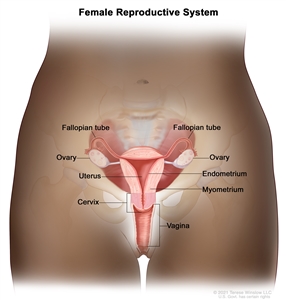
Anatomy of the female reproductive system. The organs in the female reproductive system include the uterus, ovaries, fallopian tubes, cervix, and vagina. The uterus has a muscular outer layer called the myometrium and an inner lining called the endometrium.
Uterine sarcoma is a very rare kind of cancer that forms in the uterine muscles or in tissues that support the uterus. (Information about other types of sarcomas can be found in the PDQ summary on Soft Tissue Sarcoma Treatment.)
Uterine sarcoma is different from endometrial cancer, a disease in which cancer forms in the tissue that lines the uterus. Carcinosarcoma is a subtype of endometrial cancer and is staged using endometrial cancer definitions. (For more information, seeEndometrial Cancer Treatment.)
Uterine sarcomas include leiomyosarcomas, endometrial stromal sarcomas, and adenosarcomas.
Past treatment with radiation therapy to the pelvis can increase the risk of uterine sarcoma.
Anything that increases your risk of getting a disease is called a risk factor. Having a risk factor does not mean that you will get cancer; not having risk factors doesn't mean that you will not get cancer. Talk with your doctor if you think you may be at risk. Risk factors for uterine sarcoma include the following:
- Past treatment with radiation therapy to the pelvis.
- Treatment with tamoxifen for breast cancer. If you are taking this drug, have a pelvic exam every year and report any vaginal bleeding (other than menstrual bleeding) as soon as possible.
Signs of uterine sarcoma include abnormal bleeding.
Abnormal bleeding from the vagina and other signs and symptoms may be caused by uterine sarcoma or by other conditions. Check with your doctor if you have any of the following:
- Bleeding that is not part of menstrual periods.
- Bleeding after menopause.
- A mass in the vagina.
- Pain or a feeling of fullness in the abdomen.
- Frequent urination.
Tests that examine the uterus are used to diagnose uterine sarcoma.
The following tests and procedures may be used:
- Physical exam and health history: An exam of the body to check general signs of health, including checking for signs of disease, such as lumps or anything else that seems unusual. A history of the patient's health habits and past illnesses and treatments will also be taken.
-
Pelvic exam: An exam of the vagina, cervix, uterus, fallopian tubes, ovaries, and rectum. A speculum is inserted into the vagina and the doctor or nurse looks at the vagina and cervix for signs of disease. A Pap test of the cervix is usually done. The doctor or nurse also inserts one or two lubricated, gloved fingers of one hand into the vagina and places the other hand over the lower abdomen to feel the size, shape, and position of the uterus and ovaries. The doctor or nurse also inserts a lubricated, gloved finger into the rectum to feel for lumps or abnormal areas.
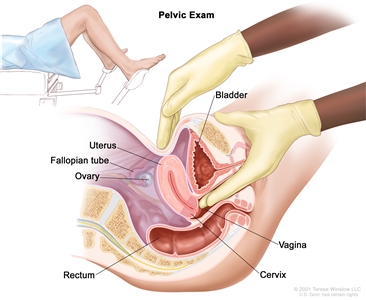
Pelvic exam. A doctor or nurse inserts one or two lubricated, gloved fingers of one hand into the vagina and presses on the lower abdomen with the other hand. This is done to feel the size, shape, and position of the uterus and ovaries. The vagina, cervix, fallopian tubes, and rectum are also checked. -
Pap test: A procedure to collect cells from the surface of the cervix and vagina. A piece of cotton, a brush, or a small wooden stick is used to gently scrape cells from the cervix and vagina. The cells are viewed under a microscope to find out if they are abnormal. This procedure is also called a Pap smear. Because uterine sarcoma begins inside the uterus, this cancer may not show up on the Pap test.
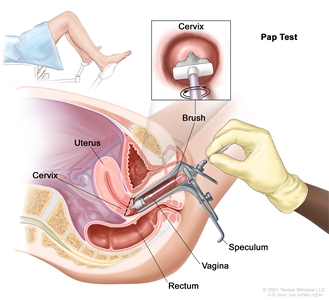
Pap test. A speculum is inserted into the vagina to widen it. Then, a brush is inserted into the vagina to collect cells from the cervix. The cells are checked under a microscope for signs of disease. -
Transvaginal ultrasound exam: A procedure used to examine the vagina, uterus, fallopian tubes, and bladder. An ultrasound transducer (probe) is inserted into the vagina and used to bounce high-energy sound waves (ultrasound) off internal tissues or organs and make echoes. The echoes form a picture of body tissues called a sonogram. The doctor can identify tumors by looking at the sonogram.
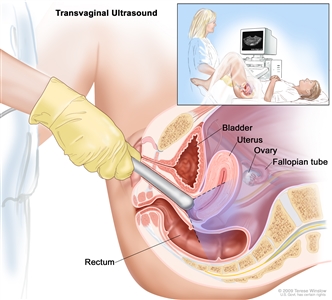
Transvaginal ultrasound. An ultrasound probe connected to a computer is inserted into the vagina and is gently moved to show different organs. The probe bounces sound waves off internal organs and tissues to make echoes that form a sonogram (computer picture). -
Dilatation and curettage: A procedure to remove samples of tissue from the inner lining of the uterus. The cervix is dilated and a curette (spoon-shaped instrument) is inserted into the uterus to remove tissue. The tissue samples are checked under a microscope for signs of disease. This procedure is also called a D&C.
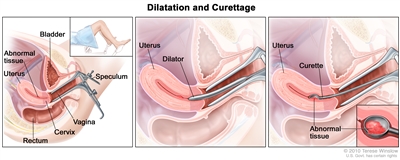
Dilatation and curettage (D and C). A speculum is inserted into the vagina to widen it in order to look at the cervix (first panel). A dilator is used to widen the cervix (middle panel). A curette is put through the cervix into the uterus to scrape out abnormal tissue (last panel). - Endometrial biopsy: The removal of tissue from the endometrium (inner lining of the uterus) by inserting a thin, flexible tube through the cervix and into the uterus. The tube is used to gently scrape a small amount of tissue from the endometrium and then remove the tissue samples. A pathologist views the tissue under a microscope to look for cancer cells.
Certain factors affect prognosis (chance of recovery) and treatment options.
The prognosis and treatment options depend on the following:
- The stage of the cancer.
- The type and size of the tumor.
- The patient's general health.
- Whether the cancer has just been diagnosed or has recurred (come back).
Stages of Uterine Sarcoma
After uterine sarcoma has been diagnosed, tests are done to find out if cancer cells have spread within the uterus or to other parts of the body.
The process used to find out if cancer has spread within the uterus or to other parts of the body is called staging. The information gathered from the staging process determines the stage of the disease. It is important to know the stage in order to plan treatment. The following procedures may be used in the staging process:
- Blood chemistry studies: A procedure in which a blood sample is checked to measure the amounts of certain substances released into the blood by organs and tissues in the body. An unusual (higher or lower than normal) amount of a substance can be a sign of disease.
- CA 125 assay: A test that measures the level of CA 125 in the blood. CA 125 is a substance released by cells into the bloodstream. An increased CA 125 level is sometimes a sign of cancer or other condition.
- Chest x-ray: An x-ray of the organs and bones inside the chest. An x-ray is a type of energy beam that can go through the body and onto film, making a picture of areas inside the body.
-
Transvaginal ultrasound exam: A procedure used to examine the vagina, uterus, fallopian tubes, and bladder. An ultrasound transducer (probe) is inserted into the vagina and used to bounce high-energy sound waves (ultrasound) off internal tissues or organs and make echoes. The echoes form a picture of body tissues called a sonogram. The doctor can identify tumors by looking at the sonogram.

Transvaginal ultrasound. An ultrasound probe connected to a computer is inserted into the vagina and is gently moved to show different organs. The probe bounces sound waves off internal organs and tissues to make echoes that form a sonogram (computer picture). - CT scan (CAT scan): A procedure that makes a series of detailed pictures of areas inside the body, such as the abdomen and pelvis, taken from different angles. The pictures are made by a computer linked to an x-ray machine. A dye may be injected into a vein or swallowed to help the organs or tissues to show up more clearly. This procedure is also called computed tomography, computerized tomography, or computerized axial tomography.
-
Cystoscopy: A procedure to look inside the bladder and urethra to check for abnormal areas. A cystoscope is inserted through the urethra into the bladder. A cystoscope is a thin, tube-like instrument with a light and a lens for viewing. It may also have a tool to remove tissue samples, which are checked under a microscope for signs of cancer.
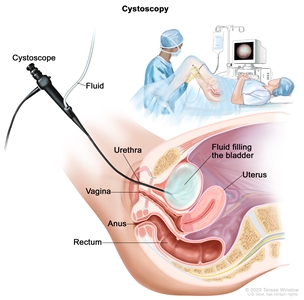
Cystoscopy. A cystoscope (a thin, tube-like instrument with a light and a lens for viewing) is inserted through the urethra into the bladder. Fluid is used to fill the bladder. The doctor looks at an image of the inner wall of the bladder on a computer monitor to check for abnormal areas.
Uterine sarcoma may be diagnosed, staged, and treated in the same surgery.
Surgery is used to diagnose, stage, and treat uterine sarcoma. During this surgery, the doctor removes as much of the cancer as possible. The following procedures may be used to diagnose, stage, and treat uterine sarcoma:
- Laparotomy: A surgical procedure in which an incision (cut) is made in the wall of the abdomen to check the inside of the abdomen for signs of disease. The size of the incision depends on the reason the laparotomy is being done. Sometimes organs are removed or tissue samples are taken and checked under a microscope for signs of disease.
- Abdominal and pelvic washings: A procedure in which a saline solution is placed into the abdominal and pelvic body cavities. After a short time, the fluid is removed and viewed under a microscope to check for cancer cells.
- Total abdominal hysterectomy: A surgical procedure to remove the uterus and cervix through a large incision (cut) in the abdomen.
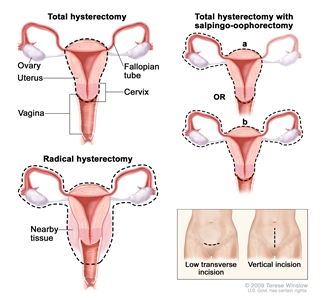
Hysterectomy. The uterus is surgically removed with or without other organs or tissues. In a total hysterectomy, the uterus and cervix are removed. In a total hysterectomy with salpingo-oophorectomy, (a) the uterus plus one (unilateral) ovary and fallopian tube are removed; or (b) the uterus plus both (bilateral) ovaries and fallopian tubes are removed. In a radical hysterectomy, the uterus, cervix, both ovaries, both fallopian tubes, and nearby tissue are removed. These procedures are done using a low transverse incision or a vertical incision. - Bilateral salpingo-oophorectomy: Surgery to remove both ovaries and both fallopian tubes.
- Lymphadenectomy: A surgical procedure in which lymph nodes are removed and checked under a microscope for signs of cancer. For a regional lymphadenectomy, some of the lymph nodes in the tumor area are removed. For a radical lymphadenectomy, most or all of the lymph nodes in the tumor area are removed. This procedure is also called lymph node dissection.
Treatment in addition to surgery may be given, as described in the Treatment Option Overview section of this summary.
There are three ways that cancer spreads in the body.
Cancer may spread from where it began to other parts of the body.
When cancer spreads to another part of the body, it is called metastasis. Cancer cells break away from where they began (the primary tumor) and travel through the lymph system or blood.
- Lymph system. The cancer gets into the lymph system, travels through the lymph vessels, and forms a tumor (metastatic tumor) in another part of the body.
- Blood. The cancer gets into the blood, travels through the blood vessels, and forms a tumor (metastatic tumor) in another part of the body.
The metastatic tumor is the same type of cancer as the primary tumor. For example, if uterine sarcoma spreads to the lung, the cancer cells in the lung are actually uterine sarcoma cells. The disease is metastatic uterine sarcoma, not lung cancer.
Cancer can spread through tissue, the lymph system, and the blood:
- Tissue. The cancer spreads from where it began by growing into nearby areas.
- Lymph system. The cancer spreads from where it began by getting into the lymph system. The cancer travels through the lymph vessels to other parts of the body.
- Blood. The cancer spreads from where it began by getting into the blood. The cancer travels through the blood vessels to other parts of the body.
The following FIGO staging system is used for leiomyosarcomas and endometrial stromal sarcomas:
Stage I
In stage I, the tumor is found in the uterus only. Stage I is divided into stages IA and IB:
- In stage IA, the tumor is 5 centimeters or smaller.
- In stage IB, the tumor is larger than 5 centimeters.

Tumor sizes are often measured in centimeters (cm) or inches. Common food items that can be used to show tumor size in cm include: a pea (1 cm), a peanut (2 cm), a grape (3 cm), a walnut (4 cm), a lime (5 cm or 2 inches), an egg (6 cm), a peach (7 cm), and a grapefruit (10 cm or 4 inches).
Stage II
In stage II, the tumor has spread beyond the uterus but has not spread beyond the pelvis. Stage II is divided into stages IIA and IIB:
- In stage IIA, the tumor has spread to the ovary, fallopian tube, or connective tissues around the uterus.
- In stage IIB, the tumor has spread to other tissues in the pelvis.
Stage III
In stage III, the tumor has spread into tissues in the abdomen. Stage III is divided into stages IIIA, IIIB, and IIIC:
- In stage IIIA, the tumor has spread to one site in the abdomen.
- In stage IIIB, the tumor has spread to more than one site in the abdomen.
- In stage IIIC, the tumor has spread to lymph nodes in the pelvis and/or around the abdominal aorta (the largest blood vessel in the abdomen).
Stage IV
Stage IV is divided into stages IVA and IVB:
- In stage IVA, the tumor has spread into the bladder and/or the rectum.
- In stage IVB, the tumor has spread to distant parts of the body.
The following FIGO staging system is used for adenosarcomas:
Stage I
In stage I, the tumor is found in the uterus only. Stage I is divided into stages IA, IB, and IC:
- In stage IA, the tumor is found in the endometrium or endocervix (the inner part of the cervix that forms a canal connecting the vagina to the uterus).
- In stage IB, the tumor has spread halfway or less into the myometrium (the muscular outer layer of the uterus).
- In stage IC, the tumor has spread more than halfway into the myometrium.
Stage II
In stage II, the tumor has spread outside the uterus into the pelvis. Stage II is divided into stages IIA and IIB:
- In stage IIA, the tumor has spread to the ovary, fallopian tube, or connective tissues around the uterus.
- In stage IIB, the tumor has spread to other tissues in the pelvis.
Stage III
In stage III, the tumor has spread into tissues in the abdomen. Stage III is divided into stages IIIA, IIIB, and IIIC:
- In stage IIIA, the tumor has spread to one site in the abdomen.
- In stage IIIB, the tumor has spread to more than one site in the abdomen.
- In stage IIIC, the tumor has spread to lymph nodes in the pelvis and/or around the abdominal aorta (the largest blood vessel in the abdomen).
Stage IV
Stage IV is divided into stages IVA and IVB:
- In stage IVA, the tumor has spread into the bladder and/or the rectum.
- In stage IVB, the tumor has spread to distant parts of the body.
Uterine sarcoma can recur (come back) after it has been treated.
The cancer may come back in the uterus, the pelvis, or in other parts of the body.
Treatment Option Overview
There are different types of treatment for patients with uterine sarcoma.
Different types of treatments are available for patients with uterine sarcoma. Some treatments are standard (the currently used treatment), and some are being tested in clinical trials. A treatment clinical trial is a research study meant to help improve current treatments or obtain information on new treatments for patients with cancer. When clinical trials show that a new treatment is better than the standard treatment, the new treatment may become the standard treatment. Patients may want to think about taking part in a clinical trial. Some clinical trials are open only to patients who have not started treatment.
The following types of treatment are used:
Surgery
Surgery is the most common treatment for uterine sarcoma, as described in the Stages of Uterine Sarcoma section of this summary.
After the doctor removes all the cancer that can be seen at the time of the surgery, some patients may be given chemotherapy or radiation therapy after surgery to kill any cancer cells that are left. Treatment given after the surgery, to lower the risk that the cancer will come back, is called adjuvant therapy.
Radiation therapy
Radiation therapy is a cancer treatment that uses high energy x-rays or other types of radiation to kill cancer cells or keep them from growing. There are two types of radiation therapy:
- External radiation therapy uses a machine outside the body to send radiation toward the area of the body with cancer.
- Internal radiation therapy uses a radioactive substance sealed in needles, seeds, wires, or catheters that are placed directly into or near the cancer.
The way the radiation therapy is given depends on the type and stage of the cancer being treated. External and internal radiation therapy are used to treat uterine sarcoma, and may also be used as palliative therapy to relieve symptoms and improve quality of life.
Chemotherapy
Chemotherapy is a cancer treatment that uses drugs to stop the growth of cancer cells, either by killing the cells or by stopping them from dividing. When chemotherapy is taken by mouth or injected into a vein or muscle, the drugs enter the bloodstream and can reach cancer cells throughout the body (systemic chemotherapy).
Hormone therapy
Hormone therapy is a cancer treatment that removes hormones or blocks their action and stops cancer cells from growing. Hormones are substances produced by glands in the body and circulated in the bloodstream. Some hormones can cause certain cancers to grow. If tests show the cancer cells have places where hormones can attach (receptors), drugs, surgery, or radiation therapy is used to reduce the production of hormones or block them from working.
New types of treatment are being tested in clinical trials.
Information about clinical trials is available from the NCI website.
Treatment for uterine sarcoma may cause side effects.
For information about side effects caused by treatment for cancer, visit our Side Effects page.
Patients may want to think about taking part in a clinical trial.
For some patients, taking part in a clinical trial may be the best treatment choice. Clinical trials are part of the cancer research process. Clinical trials are done to find out if new cancer treatments are safe and effective or better than the standard treatment.
Many of today's standard treatments for cancer are based on earlier clinical trials. Patients who take part in a clinical trial may receive the standard treatment or be among the first to receive a new treatment.
Patients who take part in clinical trials also help improve the way cancer will be treated in the future. Even when clinical trials do not lead to effective new treatments, they often answer important questions and help move research forward.
Patients can enter clinical trials before, during, or after starting their cancer treatment.
Some clinical trials only include patients who have not yet received treatment. Other trials test treatments for patients whose cancer has not gotten better. There are also clinical trials that test new ways to stop cancer from recurring (coming back) or reduce the side effects of cancer treatment.
Clinical trials are taking place in many parts of the country. Information about clinical trials supported by NCI can be found on NCI's clinical trials search webpage. Clinical trials supported by other organizations can be found on the ClinicalTrials.gov website.
Follow-up tests may be needed.
As you go through treatment, you will have follow-up tests or check-ups. Some tests that were done to diagnose or stage the cancer may be repeated to see how well the treatment is working. Decisions about whether to continue, change, or stop treatment may be based on the results of these tests.
Some of the tests will continue to be done from time to time after treatment has ended. The results of these tests can show if your condition has changed or if the cancer has recurred (come back).
Treatment of Stage I Uterine Sarcoma
For information about the treatments listed below, see the Treatment Option Overview section.
Treatment of stage I leiomyosarcoma of the uterus, stage I endometrial stromal sarcoma, and stage I adenosarcoma of the uterus may include the following:
- Surgery (total abdominal hysterectomy, bilateral salpingo-oophorectomy, and lymphadenectomy).
- Surgery followed by radiation therapy to the pelvis.
- Surgery followed by chemotherapy.
Use our clinical trial search to find NCI-supported cancer clinical trials that are accepting patients. You can search for trials based on the type of cancer, the age of the patient, and where the trials are being done. General information about clinical trials is also available.
Treatment of Stage II Uterine Sarcoma
For information about the treatments listed below, see the Treatment Option Overview section.
Treatment of stage II leiomyosarcoma of the uterus, stage II endometrial stromal sarcoma, and stage II adenosarcoma of the uterus may include the following:
- Surgery (total abdominal hysterectomy, bilateral salpingo-oophorectomy, and lymphadenectomy).
- Surgery followed by radiation therapy to the pelvis.
- Surgery followed by chemotherapy.
Use our clinical trial search to find NCI-supported cancer clinical trials that are accepting patients. You can search for trials based on the type of cancer, the age of the patient, and where the trials are being done. General information about clinical trials is also available.
Treatment of Stage III Uterine Sarcoma
For information about the treatments listed below, see the Treatment Option Overview section.
Treatment of stage III leiomyosarcoma of the uterus, stage III endometrial stromal sarcoma, and stage III adenosarcoma of the uterus may include the following:
- Surgery (total abdominal hysterectomy, bilateral salpingo-oophorectomy, lymphadenectomy, and removal of all other tissue where tumor is found).
- A clinical trial of surgery followed by radiation therapy to the pelvis.
- A clinical trial of surgery followed by chemotherapy.
Use our clinical trial search to find NCI-supported cancer clinical trials that are accepting patients. You can search for trials based on the type of cancer, the age of the patient, and where the trials are being done. General information about clinical trials is also available.
Treatment of Stage IV Uterine Sarcoma
There is no standard treatment for patients with stage IV leiomyosarcoma of the uterus, stage IV endometrial stromal sarcoma, or stage IV adenosarcoma of the uterus. Treatment may include a clinical trial using chemotherapy.
Use our clinical trial search to find NCI-supported cancer clinical trials that are accepting patients. You can search for trials based on the type of cancer, the age of the patient, and where the trials are being done. General information about clinical trials is also available.
Treatment of Recurrent Uterine Sarcoma
For information about the treatments listed below, see the Treatment Option Overview section.
There is no standard treatment for recurrent uterine sarcoma. Treatment may include a clinical trial using chemotherapy.
For patients with recurrent carcinosarcoma (a certain type of tumor), treatment may include the following:
- Radiation therapy as palliative therapy to relieve symptoms (such as pain, nausea, or bowel problems) and improve the quality of life.
- Hormone therapy.
- A clinical trial of a new treatment.
Use our clinical trial search to find NCI-supported cancer clinical trials that are accepting patients. You can search for trials based on the type of cancer, the age of the patient, and where the trials are being done. General information about clinical trials is also available.
To Learn More About Uterine Sarcoma
For more information from the National Cancer Institute about uterine sarcoma, see the Uterine Cancer Home Page.
For general cancer information and other resources from the National Cancer Institute, visit:
About This PDQ Summary
About PDQ
Physician Data Query (PDQ) is the National Cancer Institute's (NCI's) comprehensive cancer information database. The PDQ database contains summaries of the latest published information on cancer prevention, detection, genetics, treatment, supportive care, and complementary and alternative medicine. Most summaries come in two versions. The health professional versions have detailed information written in technical language. The patient versions are written in easy-to-understand, nontechnical language. Both versions have cancer information that is accurate and up to date and most versions are also available in Spanish.
PDQ is a service of the NCI. The NCI is part of the National Institutes of Health (NIH). NIH is the federal government's center of biomedical research. The PDQ summaries are based on an independent review of the medical literature. They are not policy statements of the NCI or the NIH.
Purpose of This Summary
This PDQ cancer information summary has current information about the treatment of uterine sarcoma. It is meant to inform and help patients, families, and caregivers. It does not give formal guidelines or recommendations for making decisions about health care.
Reviewers and Updates
Editorial Boards write the PDQ cancer information summaries and keep them up to date. These Boards are made up of experts in cancer treatment and other specialties related to cancer. The summaries are reviewed regularly and changes are made when there is new information. The date on each summary ("Updated") is the date of the most recent change.
The information in this patient summary was taken from the health professional version, which is reviewed regularly and updated as needed, by the PDQ Adult Treatment Editorial Board.
Clinical Trial Information
A clinical trial is a study to answer a scientific question, such as whether one treatment is better than another. Trials are based on past studies and what has been learned in the laboratory. Each trial answers certain scientific questions in order to find new and better ways to help cancer patients. During treatment clinical trials, information is collected about the effects of a new treatment and how well it works. If a clinical trial shows that a new treatment is better than one currently being used, the new treatment may become "standard." Patients may want to think about taking part in a clinical trial. Some clinical trials are open only to patients who have not started treatment.
Clinical trials can be found online at NCI's website. For more information, call the Cancer Information Service (CIS), NCI's contact center, at 1-800-4-CANCER (1-800-422-6237).
Permission to Use This Summary
PDQ is a registered trademark. The content of PDQ documents can be used freely as text. It cannot be identified as an NCI PDQ cancer information summary unless the whole summary is shown and it is updated regularly. However, a user would be allowed to write a sentence such as "NCI's PDQ cancer information summary about breast cancer prevention states the risks in the following way: [include excerpt from the summary]."
The best way to cite this PDQ summary is:
PDQ® Adult Treatment Editorial Board. PDQ Uterine Sarcoma Treatment. Bethesda, MD: National Cancer Institute. Updated <MM/DD/YYYY>. Available at: https://www.cancer.gov/types/uterine/patient/uterine-sarcoma-treatment-pdq. Accessed <MM/DD/YYYY>. [PMID: 26389379]
Images in this summary are used with permission of the author(s), artist, and/or publisher for use in the PDQ summaries only. If you want to use an image from a PDQ summary and you are not using the whole summary, you must get permission from the owner. It cannot be given by the National Cancer Institute. Information about using the images in this summary, along with many other images related to cancer can be found in Visuals Online. Visuals Online is a collection of more than 3,000 scientific images.
Disclaimer
The information in these summaries should not be used to make decisions about insurance reimbursement. More information on insurance coverage is available on Cancer.gov on the Managing Cancer Care page.
Contact Us
More information about contacting us or receiving help with the Cancer.gov website can be found on our Contact Us for Help page. Questions can also be submitted to Cancer.gov through the website's E-mail Us.
Last Revised: 2022-10-07
If you want to know more about cancer and how it is treated, or if you wish to know about clinical trials for your type of cancer, you can call the NCI's Cancer Information Service at 1-800-422-6237, toll free. A trained information specialist can talk with you and answer your questions.
This information does not replace the advice of a doctor. Ignite Healthwise, LLC disclaims any warranty or liability for your use of this information. Your use of this information means that you agree to the Terms of Use and Privacy Policy. Learn how we develop our content.
Healthwise, Healthwise for every health decision, and the Healthwise logo are trademarks of Ignite Healthwise, LLC.

